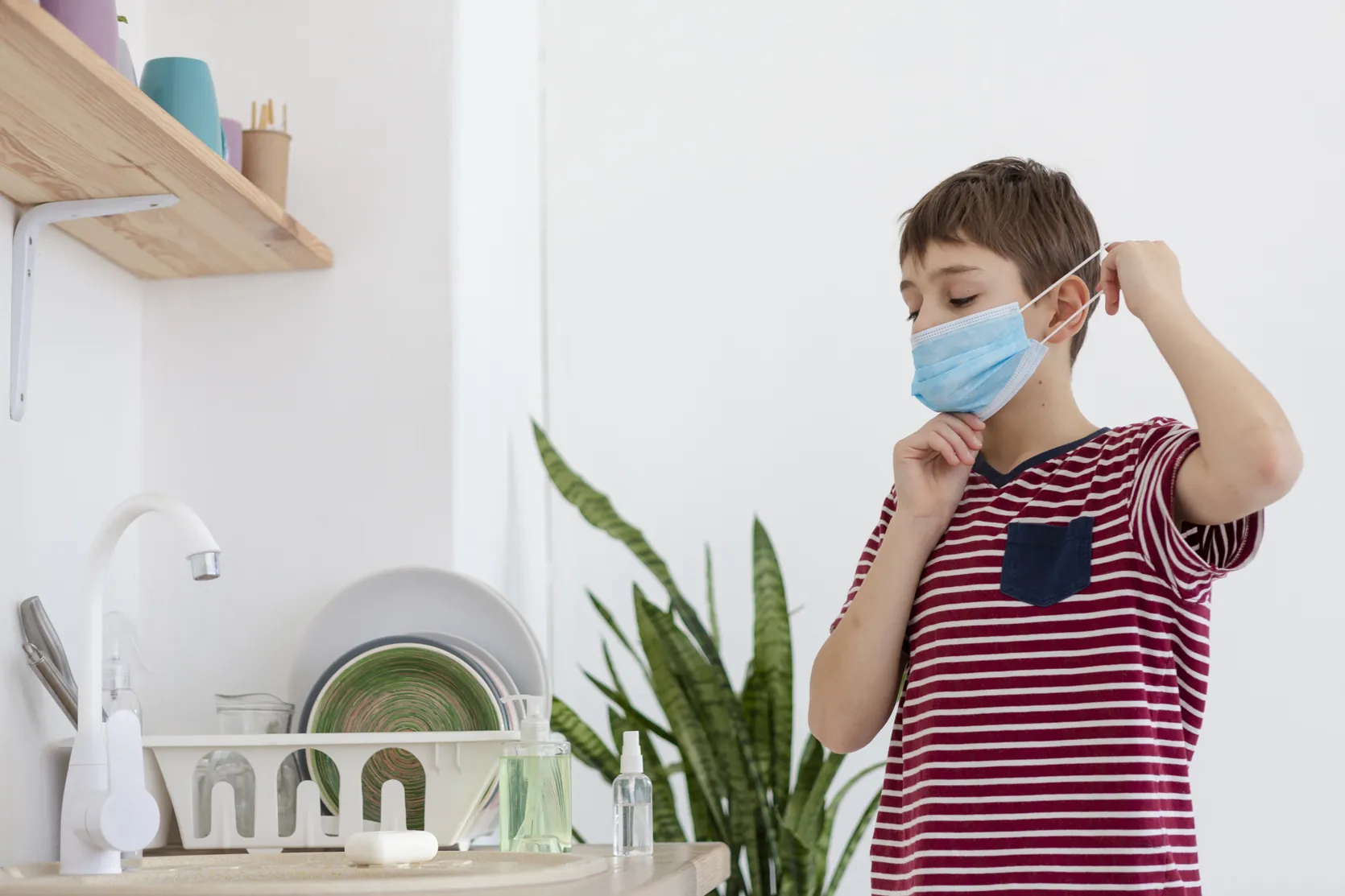How to Avoid Indoor Air Pollution
Does the air feel muggy or suffocating at home or at work? Are you smelling something that doesn't seem quite right, and your nose or your eyes get irritated quickly? This might be a case of indoor air pollution. Indoor environments can quickly be contaminated with harmful gases, chemicals, fine matter, bacteria, and other pollutants that can affect the safety and well-being of occupants. In our world today, you need to be more vigilant.
What is indoor air pollution?
Indoor air pollution refers to the release and presence of contaminants or pollutants in the air inside buildings and enclosed residential spaces, such as homes, offices, schools, and other indoor environments. These pollutants can be harmful to human health and pose serious health risks when they reach high concentrations or are present for extended periods.
Usually, residents, employees, and construction workers are more likely to be at risk because of indoor air pollution because they live or stay in specific enclosed spaces for long periods of time. Some studies report that people actually spend more than 90% of their time indoors. Now, some may believe that indoor air or household air is better than outdoor air. However, poor indoor air can easily go undetected and eventually become a health concern. Indoor air pollution is a problem that shouldn’t be ignored.
Types of indoor air pollution
Indoor air pollution encompasses a wide range of pollutants. Here are some common types of indoor air pollutants:
- Particulate Matter (PM): These are tiny airborne particles that can include dust, pollen, mold spores, pet dander, and smoke. Particulate matter can irritate the respiratory system and contribute to allergies and asthma.
- Volatile Organic Compounds (VOCs): VOCs are organic chemicals that can evaporate into the air from products like paints, solvents, cleaning agents, furniture, and building materials. Prolonged exposure to VOCs can lead to respiratory irritation and other health issues.
- Radon: Radon is a naturally occurring radioactive gas that can enter homes through the ground. It is odorless, colorless, and tasteless, and it is a leading cause of lung cancer when it accumulates significantly in indoor air.
- Carbon Monoxide (CO): Carbon monoxide, like radon, is a colorless, odorless gas produced by the incomplete combustion of fuels such as wood, natural gas, and gasoline. High levels of CO can be deadly, causing symptoms like headaches, dizziness, and nausea.
- Tobacco Smoke: Smoking indoors releases a wide range of harmful chemicals and particulates into the air. This leads to serious health risks for both smokers and nonsmokers.
- Biological Contaminants: These include mold, bacteria, viruses, and allergens from pests like dust mites and cockroaches. Exposure to biological contaminants can result in allergies, respiratory infections, and various other health problems.
- Asbestos: Older building materials may contain asbestos, which, when disturbed, releases harmful fibers into the air. Inhalation of asbestos fibers can lead to lung diseases, including cancer. Worse cases and exposure also lead to death, as asbestos kills around 5,000 workers each year.
- Lead: Lead dust from deteriorating lead-based paint or contaminated soil can become airborne. Lead-based indoor air pollution poses a risk of lead poisoning, especially for children.
- Pesticides: The excessive use of pesticides indoors can result in the release of harmful chemicals into the air, potentially leading to health problems.
- Ozone: Ozone is a reactive gas that can be emitted by certain appliances like photocopiers and laser printers. While ozone at ground level can be harmful to health, it's different from the ozone layer in the Earth's atmosphere.
These are some of the primary types of indoor air pollution. However, there may be other specific pollutants depending on the sources and activities in and around a particular indoor environment.
What are the causes of indoor air pollution?
Indoor air pollution is caused by various factors and sources that release pollutants into an indoor environment, affecting the occupants of the area. It’s important that people are more aware of these sources so as to know how to maintain good air quality indoors.
The causes of indoor air pollution include:
- Tobacco Smoke: Smoking indoors is a significant source of indoor air pollution. Cigarette smoke contains thousands of chemicals, many of which are harmful and can linger in the air for long periods.
- Combustion Appliances: Appliances that burn solid fuels (e.g., wood, coal) or use natural gas, propane, or oil for heating and cooking can release pollutants such as carbon monoxide (CO), nitrogen dioxide (NO2), and fine particulate matter (PM) into the air if they are not properly vented or maintained.
- Building Materials and Furnishings: Some building materials and furnishings can emit volatile organic compounds (VOCs) and other chemicals from products like paints, varnishes, flooring, and furniture. VOCs, including benzene, formaldehyde, and toluene, are harmful and can react with other gases or form a new pollutant altogether.
- Household Cleaning and Personal Care Products: Many household cleaning products, air fresheners, and personal care items contain VOCs and other chemicals as well. These gases and chemicals can contribute to indoor air pollution when used in enclosed spaces.
- Mold and Moisture: Damp or humid indoor environments can promote the growth of mold and mildew. These things release spores and mycotoxins that can be inhaled and cause health problems for the occupants.
- Pesticides: The use of pesticides and insecticides indoors can introduce toxic chemicals into the air. Improperly stored pesticides can also contribute to indoor air pollution.
- Household Activities: Everyday activities such as cooking, heating, and cleaning can release pollutants into the air. For example, cooking with gas stoves can produce NO2 and other pollutants.
- Pets: Pets can shed allergenic proteins, and their dander, saliva, and urine can contribute to indoor air pollution. This can be particularly hard for individuals with pet allergies.
- Inadequate Ventilation: Poor ventilation in indoor spaces can trap pollutants and reduce the exchange of indoor and outdoor air. This leads to higher pollutant concentrations in a living environment.
- Infiltration of Outdoor Pollutants: Outdoor pollutants, such as vehicle exhaust, pollen, and industrial emissions, can enter indoor spaces through open windows, doors, and cracks in the building envelope.
- Occupant Activities: Human activities, such as shedding skin cells, can contribute to indoor air pollution by providing a source of allergens and particulate matter. Dust is made up of dead skin cells, which can contribute to more dust mite matter and result in poor indoor air quality.
- Older Building Materials: Some older buildings may contain harmful materials like asbestos, lead-based paint, or deteriorating insulation. These can release harmful pollutants when disturbed.
- Inadequate Maintenance: Poor maintenance of HVAC (heating, ventilation, and air conditioning) systems, filters, and ventilation systems can result in the buildup of pollutants and reduce indoor air quality.
Identifying the specific sources of indoor air pollution in a particular environment is crucial for effectively addressing and mitigating the problem. With this knowledge, people have the chance to improve ventilation, utilize smart air quality monitors, use air purifiers with appropriate filters, eliminate or minimize pollutant sources, and practice good indoor hygiene and maintenance.
What are the effects of indoor air pollution?
Severe indoor air quality can affect those who live or work in various enclosed spaces. They can have a range of immediate and long-term effects on human health and well-being, depending on the type and concentration of pollutants as well as individual susceptibility.
Here are some of the harmful impacts of indoor air pollution:
Immediate Effects of Indoor Air Pollution
- Irritation of the Eyes, Nose, and Throat: Exposure to indoor air pollutants like particulate matter, tobacco smoke, volatile organic compounds (VOCs), and other household chemicals can cause immediate irritation of the eyes, nose, and throat. This can result in symptoms such as red eyes, runny nose, coughing, and sore throat.
- Respiratory Symptoms: Pollutants like dust, allergens, and mold spores can trigger or worsen existing respiratory conditions. They can lead to symptoms like wheezing, shortness of breath, and chest tightness.
- Aggravation of Allergies: Indoor allergens such as dust mites, pet dander, and mold, on the other hand, can exacerbate allergy symptoms in individuals who are sensitive to these substances. This can lead to sneezing, congestion, and itchy or watery eyes.
- Headaches and Fatigue: Poor indoor air quality, especially due to the presence of chemicals like formaldehyde and certain VOCs, can cause headaches, dizziness, and fatigue for occupants.
Long-Term Effects of Indoor Air Pollution
- Respiratory Diseases: Prolonged exposure to indoor air pollutants, particularly tobacco smoke and fine particulate matter, can increase the risk of developing respiratory diseases. This includes chronic obstructive pulmonary disease (COPD) and asthma.
- Cardiovascular Problems: Indoor air pollution has been linked to an increased risk of heart disease, including heart attacks and strokes. This is partly due to the effects of fine particulate matter and carbon monoxide on the cardiovascular system.
- Cancer: Some indoor air pollutants, such as radon and certain VOCs, are known carcinogens and can increase the risk of developing cancer. Tobacco and radon are especially known to be leading causes of lung cancer and cancer deaths.
- Neurological Effects: Emerging research suggests that long-term exposure to certain indoor air pollutants (fine particulate matter PM2.5) may be associated with neurological problems, including cognitive impairment and developmental issues in children.
- Worsening of Existing Health Conditions: Indoor air pollution can worsen pre-existing health conditions, including allergies, asthma, and other respiratory diseases. If a person has a viral illness, this can also make managing the condition more challenging.
- Reduced Lung Function: Children exposed to indoor air pollutants like secondhand smoke may experience reduced lung development. This can then lead to long-term respiratory problems as they grow.
It's important to remember that the severity of these effects can vary depending on factors as well. To reduce the immediate and long-term health risks associated with indoor air pollution, it's essential to take steps to improve indoor air quality through proper monitoring, ventilation, filtration, and the elimination or reduction of pollutant sources.
How to avoid air pollution?
Maintaining a healthy indoor air environment is key to avoiding air pollution. One must always be ready and proactive when it comes to the air you breathe inside. The more you know about maintaining good air quality, the more you can keep yourself, your family, or other people safe in your home or workplace.
Here are several steps you can take to reduce the risks of poor indoor air quality and avoid indoor air pollution:
- No smoking indoors: If you or others in your household or workplace smoke, make it a rule to smoke outdoors. Smoking indoors is a major source of indoor air pollution and poses significant health risks to people.
- Ensure proper ventilation: Adequate ventilation is key to reducing indoor air pollution. Use exhaust fans in bathrooms and kitchens to remove moisture and pollutants. Open windows and doors when the weather permits to allow fresh outdoor air to circulate through your home.
- Maintain heating and cooling systems: Regularly service and maintain your HVAC systems. Change filters as recommended and ensure that ducts are clean and free from leaks.
- Use air purifiers: High-efficiency particulate air (HEPA) filters can help remove particles like dust, pollen, and pet dander from the air. Air purifiers with activated carbon filters can also help reduce odors and remove some VOCs in an enclosed space.
- Control moisture: Moisture can lead to mold growth and attract dust mites. Use dehumidifiers if necessary to maintain indoor humidity levels between 30% and 50%. Fix any leaks promptly, and clean and dry water-damaged areas.
- Limit or eliminate VOCs: Choose low-VOC or VOC-free products when painting, renovating, or purchasing furniture and building materials. Properly ventilate areas where VOC-emitting products are used.
- Reduce pesticide use: Use non-toxic methods to control pests whenever possible. If you must use pesticides, follow label instructions carefully and store them securely.
- Regularly clean and dust: Frequent cleaning and dusting can help reduce allergens and particles in your home. Vacuum with a HEPA filter-equipped vacuum cleaner and wash bedding and curtains regularly.
- Manage pet allergens: If you have pets, groom them regularly, and vacuum floors and furniture to remove pet hair and dander. Consider using allergen-resistant bedding and upholstery covers.
- Test for radon: If you live or work in an area with a known radon risk, consider testing your home or office for radon gas.
- Address mold issues: If you discover mold in your home, take steps to remove it promptly and fix the underlying moisture problem. In some cases, you may need professional mold remediation.
- Properly store and dispose of household chemicals: Keep household cleaning products, paints, and other chemicals in a well-ventilated area and out of reach of children. Follow disposal guidelines for hazardous materials.
- Regularly inspect and maintain your home or living space: Older homes or residential buildings may have materials that contain lead or asbestos. If your home was built before the 1980s, consider having it inspected for these hazards, and address any issues found by qualified professionals.
- Promote good hygiene: Encourage good hygiene practices, such as washing hands, regularly changing and laundering bedding, and keeping living spaces clean.
- Use a smart air quality monitor: Using smart, portable air quality monitors can be one of the easiest and most effective ways to avoid indoor air pollution. SOLUM Roommate, for example, can be plugged into an outlet, and it can immediately monitor the air quality and alert residents if they need to evacuate or take action.
SOLUM Roommate Against Indoor Air Pollution
SOLUM’s portable air quality monitor is a good tool to have in every household and even in the workplace. With indoor air pollution slowly becoming crucial everywhere people stay, the need for an air quality monitor like SOLUM Roommate increases.
SOLUM Roommate has:
- Air quality monitoring and measuring
- Downloadable SOLUM Roommate app
- Built-in motion detector
- LED light indicators
- Temperature monitor
- Humidity level monitor
- Discomfort index monitor
Get an air quality monitor and keep these preventive measures in mind so you can create a healthier living environment for yourself and your family. Want to learn more about how SOLUM Roommate can help you stay safe against poor indoor air quality? Talk to our experts now.











